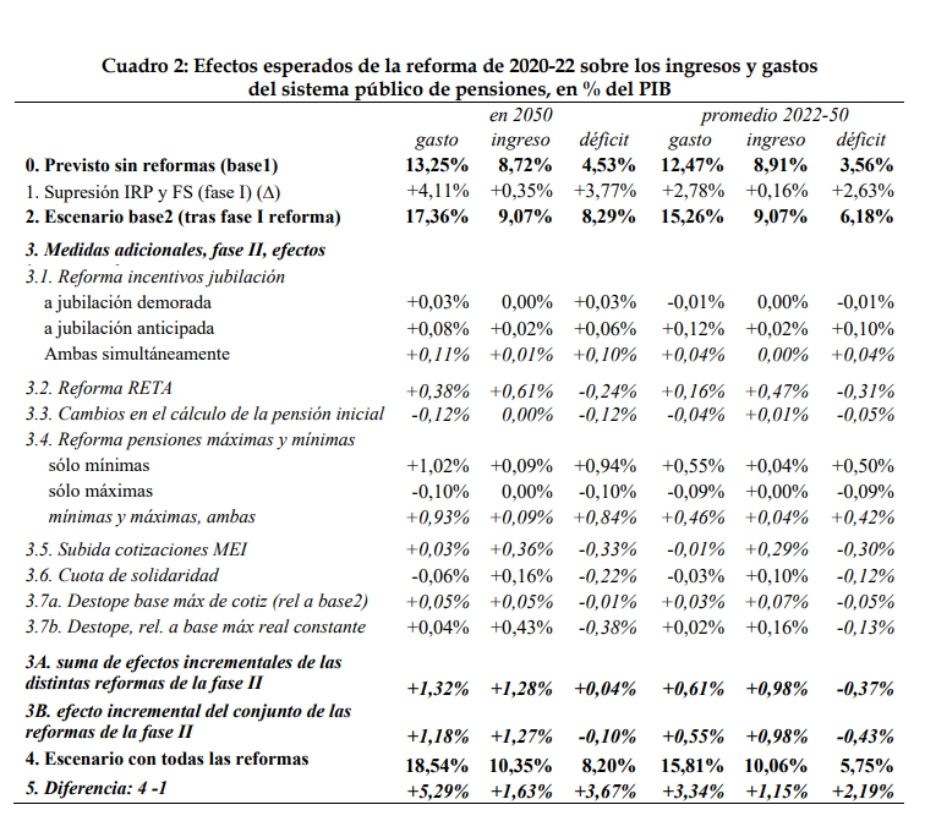Public debt will increase from 2030 due to aging and ‘baby boom’, alerts airf
Fedea proposes to delay retirement age and raise pensions less than the CPI
A new work of the Foundation of Applied Economics Studies (Fedea @Socialfedea), published on Monday, delves into the pension system challenges until 2050, For aging, the Retirement of the Baby Boom generation and the greatest expense that will carry the latest changes in the retirement system.
The study, Impact of the pension reform of 2021-23, Analyze the repercussions of recent reforms About the public social security system. Prepared by Ángel de la Fuente, Fedea director; Miguel Ángel García (Rey Juan Carlos University) and Alfonso R. Sánchez Martín (Francisco de Vitoria University), shows worrying results, among them, alerts that in 2050, pension spending will shoot at 18.5% of GDP (an increase of 5.3 points), while the contributory deficit will increase to 8.2% of GDP (an increase of 3.7 PIB points).
Consequently, in order to pay pensions, in addition to the quota increases provided by the reform, “New income will be needed (via taxes/quotes and/or debt) by value of 3.7 GDP points. “This rIt will severely educate the available income of generations following, that will suffer a deterioration of up to 10% of their consumption, ”alert the authors.

For De la Fuente, García and Sánchez, the New income in quotes are insufficient To face the highest expense derived from maintaining the Higher EU replacement rate (77% vs 44.5%) and update it with the consumer price index (CPI), whatever. “The generation Boomer She is the winner, ”in Miguel Ángel García.
Change the climb with the IPC and the pension calculation
While Fedea estimates that pension spending will reach 18.5% of GDP by 2050 as a result of pension reform as a whole, the Income will rise, but much less: They will only reach 10.35% of GDP by then.
Another consequences of reforms for the next decades is the strong increase in Basic, contributory deficit (Not counting the transfers injecting the State) that Fedea researchers say that it will shoot up to levels higher than the 8% of GDP from 2050.
“We would need to pay more attention to pension spending than the current government proposes,” underlines its report.
Among the proposed measures, the Update of pensions with the CPI, Fedea suggests restricting “the total armor” in the face of inflation and apply it only to the minimum benefits, establishing for others a Maximum limit of accumulated loss of purchasing power throughout life “that leaves a certain margin of maneuver in this area.”

Delayed and autonomous retirement will generate more expense
The reform generates a significant increase in pension spending, which not only exceeds 18% of GDP around 2050, but does it again, although slightly lesser extent, at the end of the projection horizon, which closes with an upward trend that could lead to a new maximum in the 2070 or 2080.
The bulk of the increase in spending comes from the first phase of the pension reform, the one made by the then minister José Luis Escrivá, But to him also significantly contribute the measures of the second phase, especially since 2050.
He spent that predicts the study of Fedea is much higher than what the government foresees, “By infrastimated the Ministry of Inclusion and Social Security the effect of the Deferred Retirement and the Reta In spending. “In this sense, the authors affirm that” both measures have subsequent costs when they retire, not taken into account “in official projections.
For Fedea, it is very likely that these measures are insufficient and that is necessary to inject additional resources to the system. A part of these resources, he proposes, could be achieved through the Debt issuance To return when the population pyramid is normalized to some extent, but given the “already very high” level of indebtedness, it considers that the existing margin is “very limited”.
Another possible source of additional resources, adds the body, would be a upload of social quotas, But he understands that it is not convenient to abuse this possibility.
The system is “excessively generous”
The authors of the Fedea report believe that the best starting point to design a “reasonable” pension policy would be the “explicit” recognition that the Spanish system results “excessively generous” in relation to their resources and with the expected growth of the Spanish economy.
Specifically, given the current Life expectancy after retirement (21.2 years at 65) and the expected evolution in the future of this variable (additional 4.9 years in 2050), of the levels of productivity and occupation and the relationship between the retired population and the one that is of working age, “thes current public pensions are above what wages allow and existing types of contribution. “
Fedea criticizes that the government intends to solve the problem by offering “a blank check” charged to the General State Administration.
For the Foundation, it would be necessary to seek a “more reasonable” balance between pension spending and the fiscal margin reserved for other needs. This balance could be embodied in a MEI review (Intergenerational equity mechanism), “whose activation condition It should be fixed in terms of a reasonable maximum limit to the basic deficit of the pension system (including passive classes), instead of the little transparent and excessively lax current condition. “
Lower replacement rate and count all work life
In Fedea’s opinion, we would have to reduce the current provision rate (the quotient between the pension and the average salary) to levels similar to those observed in other European economies. “To advance this direction, it will be necessary to adopt measures to contain pensions that will be extended to both present and futures, not only affecting the calculation of initial pensions, but also their revaluation.”
In these measures, he adds, the Gradual extension of the computing period for a lifetime (without allowing discards), together with a “hardening” of other parameters of the calculation of the pension and access to it, as well as the recovery of the sustainability factor or the establishment, once the ordinary retirement age of 67, of an automatic link between the legal age of retirement and the life expectancy “in good health”, with the necessary exceptions for those occupations that do not allow it for their physical hardness.


